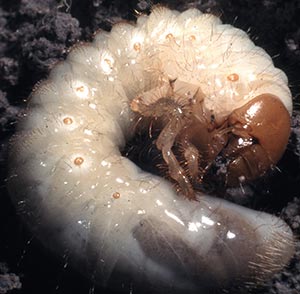
Editor’s note: In July, Dave “the BugDoc” Shetlar, Ph.D., addressed preventive and curative grub control in a webinar presented by Landscape Management and sponsored by Valent Professional Products. Here’s a bit of Q&A between Shetlar and participants on this hot topic.
Q: In Zone 9 do we really need to be concerned with grubs? —participant from South Carolina
Dave Shetlar (DS): Say what? Some of the worst grub damage I’ve seen has been in Texas and Florida. In these cases, not only were the grubs damaging the turf but the armadillos and hogs were tilling the turf. Yes, I’ve seen some pretty “good” grub infestations on Hilton Head Island, but where mole crickets were being controlled, the grubs had a difficult time surviving. On a couple of golf courses, it wasn’t the actual grub damage, but the animal digging that was the problem.
Q: How typical is it to get grubs in shaded areas? —participant from Illinois
DS: Entomologists often have stated that shaded turf is less at risk for grub infestations. However, no one told the grubs this! If you have dense turf with lots of organic matter, there will be a grub that “appreciates” this habitat. We are seeing Oriental beetles and Asiatic garden beetle grubs in some pretty dense shade.
Q: How do you recommend dealing with recurring grub problems? —participant from New York
DS: Mike Villani, Ph.D., did some studies back in the 1990s where crews surveyed white grub infestation in the Syracuse, N.Y., area. What they found was simple: If you had a damaging grub population last year, you would be at an approximate 80 percent chance of repeating it the following year.
I highly recommend keeping records of insect activity. Post a big map of your operating area and have your specialists put in a colored pin for each time they find a grub, billbug or chinch bug problem. Soon, you will see clusters of these pins in certain neighborhoods. These would be the neighborhoods that you would concentrate on selling preventive treatments.

